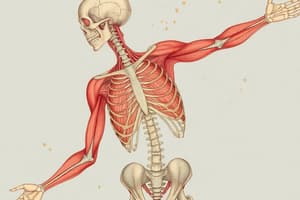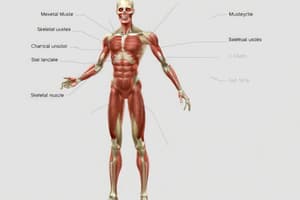Podcast
Questions and Answers
What is the primary role of fascia in muscle function?
What is the primary role of fascia in muscle function?
- To store energy for muscle contractions.
- To initiate muscle contractions during movement.
- To provide a frictionless surface allowing freedom of movement between muscles. (correct)
- To serve as a source of muscle growth factors.
Which type of muscle is characterized by having two parallel tendon sheaths?
Which type of muscle is characterized by having two parallel tendon sheaths?
- Unipennate muscles. (correct)
- Bipennate muscles.
- Multipennate muscles.
- Circular muscles.
How do synovial bursae function in relation to tendons?
How do synovial bursae function in relation to tendons?
- They act like cushions to distribute pressure from tendons. (correct)
- They facilitate muscle contractions directly.
- They provide a location for muscle attachment.
- They are involved in the storage of energy for movement.
What architectural feature of fasciae allows them to adapt to changing muscle thickness during contraction?
What architectural feature of fasciae allows them to adapt to changing muscle thickness during contraction?
What is a significant structural characteristic of synovial bursae?
What is a significant structural characteristic of synovial bursae?
What feature distinguishes deeper fascia from superficial fascia?
What feature distinguishes deeper fascia from superficial fascia?
Which muscle classification contains multiple tendon sheaths?
Which muscle classification contains multiple tendon sheaths?
How do fasciae primarily contribute to locomotion mechanics?
How do fasciae primarily contribute to locomotion mechanics?
What is the primary function of synovial bursae in the body?
What is the primary function of synovial bursae in the body?
How are synovial tendon sheaths different from synovial bursae?
How are synovial tendon sheaths different from synovial bursae?
What term describes muscles that work against each other during movement?
What term describes muscles that work against each other during movement?
What must be overcome for movement to initiate?
What must be overcome for movement to initiate?
Which layer comprises the wall of a joint?
Which layer comprises the wall of a joint?
What is muscle tonus primarily caused by?
What is muscle tonus primarily caused by?
During natural movements, how are the roles of fixed and mobile points defined?
During natural movements, how are the roles of fixed and mobile points defined?
What classification does a synovial bursa NOT fall into?
What classification does a synovial bursa NOT fall into?
What is the primary function of synovial fluid in joints?
What is the primary function of synovial fluid in joints?
Which type of synoviocyte is responsible for phagocytosis in the synovial membrane?
Which type of synoviocyte is responsible for phagocytosis in the synovial membrane?
What type of cartilage is primarily found in joints and is characterized by being smooth on the surface facing the joint?
What type of cartilage is primarily found in joints and is characterized by being smooth on the surface facing the joint?
What does the term 'hydrarthrosis' refer to in joint pathology?
What does the term 'hydrarthrosis' refer to in joint pathology?
How are the bundles of fibers in the cartilage matrix arranged?
How are the bundles of fibers in the cartilage matrix arranged?
Which layer of the synovial membrane contains the synoviocytes that produce and secrete proteins?
Which layer of the synovial membrane contains the synoviocytes that produce and secrete proteins?
Which structure is NOT typically filled with synovial fluid?
Which structure is NOT typically filled with synovial fluid?
What is a common consequence of injuries to the stratum fibrosum?
What is a common consequence of injuries to the stratum fibrosum?
Flashcards are hidden until you start studying
Study Notes
Muscle Classification
- Muscles are classified based on their structure and fiber orientation.
- Unipennate muscles have two parallel tendon sheaths, such as the ulnar and radial heads of the deep digital flexor muscle.
- Bipennate muscles have double tendon sheaths, such as the infraspinatus muscle.
- Multipennate muscles have multiple tendon sheaths, such as the humeral head of the deep digital flexor muscle.
Accessory Structures for Muscle Function
- Fasciae are thin, mesh-like sheets of collagen and elastic fibers that surround muscles, providing a frictionless surface for movement and serving as attachment sites.
- Fasciae have a mesh-like architecture that adapts to changing muscle thickness during contraction.
- Synovial bursae are enclosed in connective tissue capsules, filled with synovial fluid, and provide pressure distribution beneath tendons.
- Synovial tendon sheaths completely surround tendons, acting like a tube that protects underlying tissues from pressure and reduces friction during movement.
Locomotion and Muscle Function
- Synergistic muscles work together during movement.
- Antagonistic muscles work against each other during movement.
- Fixed point of movement is the immobile part, usually attached to the trunk.
- Punctum mobile is the moving point, smaller and lighter than the fixed point.
- Muscle function is determined by origin, placement, insertion, and point of rotation.
- Most movements involve rhythmic contractions and relaxations of antagonistic muscle groups, creating movement cycles.
- Every muscle has a certain amount of tension called muscle tonus, caused by a reflex and constant nerve stimulation.
- Hypotonus is a reduction in muscle tonus, often caused by anesthesia.
- Muscles that maintain a certain position display constant minimal muscle tonus, sometimes passively supported by tendon-like tissue within the muscle belly.
- To start a movement, both the muscle tonus of the opposing muscle and the force of gravity must be overcome.
Joint Structures and Functions
- Articular capsule surrounds the joint and consists of two layers: the stratum fibrosum and the stratum synoviale.
- Stratum fibrosum is the outer layer of the capsule, providing strength and connecting to surrounding periosteum or perichondrium.
- Stratum synoviale is the inner layer of the capsule, responsible for producing synovial fluid, containing synovial villi and folds, and containing type A and type B synoviocytes.
- Type A synoviocytes are responsible for phagocytosis.
- Type B synoviocytes produce and secrete proteins.
- Synovial fluid is a viscous fluid that lubricates the joint, reducing friction between articular surfaces, and provides nutrients to cartilage.
- Hydrarthrosis is an increase in synovial fluid production.
- Free joint bodies (joint mice) are loose pieces of cartilage or bone within the joint, often resulting from fractures or ossification of synovial villi.
- Joint cartilage is firmly attached to subchondral bone, is smooth and thin in concave areas, and thick in convex areas.
- Some areas of joint cartilage in hoofed animals have reduced cartilage, forming "synovial grooves".
- Hyaline cartilage absorbs shock, is flexible, and has viscoelastic properties.
- Joint cartilage lacks nerves and is mainly avascular, with few exceptions.
Studying That Suits You
Use AI to generate personalized quizzes and flashcards to suit your learning preferences.




